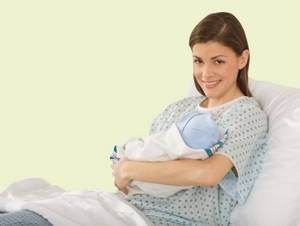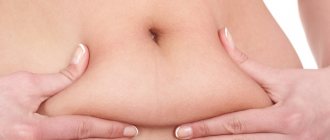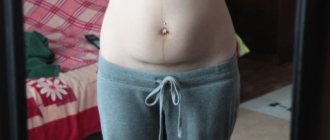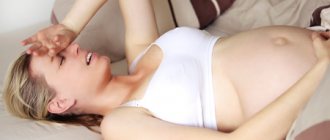Natural fears about when labor will begin and how it will go are left behind. Immediately after a woman gives birth, she is no longer called a woman in labor, but a woman giving birth. From this moment on, the early postpartum period begins. Its duration is quite short compared to the birth process itself - only two hours. And although the early postpartum period, again compared to the process of giving birth, is considered relatively easy, you should still monitor the woman’s condition as responsibly as possible.
What happens to the uterus of a postpartum mother in the early postpartum period?
Due to the fact that the uterine walls actively contract both during and immediately after natural childbirth, the uterus becomes much smaller than it was some time ago. Its walls become thicker, the shape of the uterus resembles a ball. Immediately after childbirth, due to the fact that the fixing apparatus of the uterus is greatly relaxed, it has an increased ability to move. A full bladder can also move the uterus, so it is imperative to empty it. If it is not possible to do this yourself due to postpartum swelling of the soft tissues, then you need to use a special catheter. At the beginning of the early postpartum period, the weight of the uterus is approximately 1.1 kg.
How is the early postpartum period managed?
Immediately after the birth process is completed, the woman feels very tired, but her body is now producing a huge amount of tonic hormones, so she cannot fall asleep. And that's okay. Moreover, the obstetrician-gynecologist deliberately does not allow the postpartum woman to sleep, since sleep can provoke uterine hypotension. If after childbirth a woman is overcome by vomiting and drowsiness, then there is a possibility of developing cerebral hypoxia - a consequence of large blood loss. In this case, the woman is examined to exclude internal bleeding.
Due to the fact that a woman’s intra-abdominal pressure drops sharply after childbirth, and the utero-placental circulation ceases to exist, disturbances in the functioning of the heart and blood vessels are possible in the body. Therefore, specialists constantly monitor the blood pressure of the new mother. Due to colossal nervous and physical stress, body temperature in the early postpartum period may increase slightly.
Throughout the early postpartum period (two hours), a woman who has just given birth continues to be in the delivery room with an obstetrician who closely monitors changes in her body. During this period, the discharge is profuse, with clots of dried blood. According to the rules, a woman's blood loss must be calculated. To do this, a special basin is placed under the thighs of the postpartum woman, then at the end of the early postpartum period, that is, 2 hours after birth, the blood from the vessel is drained into a measuring container to assess blood loss.
Indicators from 0.25 to 0.3 liters are considered normal. If the discharge turns out to be significantly less than normal, then suspicions arise about insufficiently active uterine contractions. In this case, the woman is given a uterotonic drug, most often oxytocin, a natural hormone responsible for uterine contractions. In parallel with the administration of the drug, the obstetrician massages the abdomen, stimulating the contractile activity of the uterus.

How is the soft birth canal examined in the early postpartum period?
In the first hour after the birth of the child, the doctor examines the soft birth canal of the mother, which includes the labia minora and majora, the clitoral area, the area of the vaginal opening - these parts are examined without additional tools, only with the help of hands after preliminary treatment of the perineal area and inner thighs women with disinfectant.
The lower part of the vagina is inspected for damage using sterile swabs. The cervix and inner walls of the vagina are examined using special clamps and large speculums.
If the doctor discovers ruptures (and this is not uncommon for natural childbirth), they are immediately stitched up. If this is not done, the risk of postpartum complications such as infection and bleeding increases significantly. In the future, ruptures in the soft birth canal that are not sutured in time lead to prolapse and even prolapse of the entire uterus. The suture material may or may not be self-absorbable. The first option does not need to remove the threads, they will dissolve on their own within a week, the second option - the stitches will need to be removed after about five days. To be fair, it should be noted that today artificial threads are practically not used for stitching perineal tears after childbirth.
New psychology of a woman after childbirth
Our entire life is represented by our perception. If we didn't feel anything, we would never know that we lived. And vice versa. We could represent only a sense organ with simulators of sensations connected to it, and with appropriate irritation of the receptors we would receive a complete sensation of real active life. Memories play an equally important role in the feeling of life, since the perception of the present occurs through the prism of accumulated experience, that is, memories. Our plans for the future are also important for the perception of reality. Few people notice the influence of the future on our lives, but this does not change matters. If you want to see for yourself, make a serious plan for the coming year, live with it for a week, carefully observing your usual reactions, and then cancel the old plan and just as seriously plan another future. I assure you that your observations will exceed any expectations.
A woman after childbirth is a person without a past and a future. Memories of the past are no longer experiences because the process of birth itself occurs in such a way as to erase them. That is, the past does not disappear anywhere, the attitude towards it just changes greatly. Memories of life before the birth of a child are more like memories of a movie you watched. The future after childbirth is practically invisible, since it is completely unclear what guidelines to plan it in relation to. Newborns or aliens who accidentally find themselves on Earth are in a similar position. In fact, this is a unique opportunity to start a new life with a new leaf, and this is not an escape from oneself and difficulties, but a completely natural and logical event.
Most often, not knowing what to do with all this now, a woman simply withdraws into her new and still very small world. She avoids communicating with her old acquaintances and certainly does not make new acquaintances. Relatives are annoying. There is not enough energy and time for communication. This condition may last for months or even years.
The reason for this behavior is that the old, what happened in the “past life”, is replaced by a new type of mental response. Monitoring her new reactions, the woman realizes with horror that she does not know how to relate to them. How to treat yourself, laughing at what you used to cry about, and completely indifferent to what once caused strong emotions. In this case, memory greatly interferes with living.
A narrowing circle of contacts leads to a narrowing of the area of movement, which in turn leads to monotony of impressions and a gradual slide into depression. Of course, this has nothing to do with recovery.
The basis of the entire recovery process is the development of a new way of mental response . This does not mean accustoming yourself to any specific reactions, but studying your own reactions that have changed after childbirth. Simply put, you need to get to know yourself again and accept yourself as you are, without beating around the bush.
Most often, the process of postpartum rehabilitation is stopped at the very beginning. The young mother is surrounded by care and affection from her family and friends. Everyone comes to visit to look at the newborn and share personal or other people's experiences. Newly-made grandmothers are especially eager to help. They not only vie with each other to teach the woman the intricacies of washing dirty bottoms and the like, but they also strive to do everything themselves, offering the child’s mother to “rest.” As a result, all the energy and all the attention goes into the struggle for the opportunity to be the mother of her child.
To prevent this from happening and for a woman after giving birth to be able to focus on herself, her new perception of the world, study herself and understand what she is today, I propose a set of measures.
- Inform relatives and friends about the birth of a child with a week delay . This will allow the whole family to recover after childbirth and prepare for “relative aggression.”
- Strictly determine the time of visits with family and friends in the first months after childbirth and do not receive guests more than once a week and for no more than two hours. And let them come one at a time, or at least two at a time. This will prevent you from imposing help and saying a bunch of unnecessary advice. All fears and prejudices are extremely contagious, and it is relatives who are usually the main carriers of this nasty thing. In addition, this can be motivated by hygienic considerations.
- If a mother-in-law or mother-in-law lives in a family, a young mother must courageously take on household chores. There can only be one mistress in a house. Grandmothers should live for their own pleasure - going to theaters, meeting friends, traveling. If you manage to get such a grandmother, everyone will be happy. True, not right away. At first, the grandmother sent “for a walk” may be offended, but sooner or later she herself will thank you for not letting her get bogged down in the abyss of someone else’s family life.
- From the first minutes of motherhood, carefully observe all your reactions and manifestations. Observations should not be interrupted by any assessments or analyses. You should observe and at the same time try to “be in yourself” all the time, that is, perceive as intently as possible exactly what is happening here and now. This observation will allow you to know yourself. Take everything for granted. Do not be surprised by new products, because from now on these are not new products, but your mental properties and characteristics. Get rid of thoughts like “I’ve never done this before” or “I would never have allowed myself to do this before.” These are harmful and incorrect thoughts, because for a woman after childbirth, “earlier” does not exist.
- Find out for yourself your new relationship with everyone around you. Just decide how you now feel about your husband, father, mother, aunts and uncles, girlfriends and friends. Accept this relationship for what it is. There's nothing you can do about it. If you try to lie to yourself, you will make enemies and troubles, and maybe even ruin your life. And don’t let material considerations cloud your consciousness. Believe me, they are not worth it.
Currently reading: Strength training may help reduce risk of heart attack in men
For a speedy recovery, as well as to prepare for life in changed conditions, it would not hurt a woman to grow up. This can be done only by resorting to the independent cultivation of mature perception.
Late postpartum period. When does it start and how long does it last?
After stitching the tears, two hours after birth, the woman and the newborn are transferred to another department - the postpartum department. But before this, the obstetrician and doctor measure the height of the uterus, its consistency, draw a conclusion about the nature and abundance of vaginal discharge, measure the pulse rate, body temperature and blood pressure. After all these procedures, the woman enters the late labor period, which is much longer and, in a sense, somewhat more difficult than the early one. The late postpartum period lasts up to one and a half months or six weeks.
The late postpartum period is characterized by involution of the organs of the reproductive system. Involution is called reverse development. That is, the genitals and all other organs that were previously involved in the process of pregnancy and childbirth return to their natural size. If the child is breastfed, the mammary glands will undergo reverse development only after the end of the breastfeeding process. After completion of lactation, the ovarian-uterine cycles will also be restored. Read about when your first period comes after childbirth on our website.
Changes in a woman's body associated with childbirth
Changes in the female body are caused by both physiological and mental mechanisms.
Currently reading: Exercise increases satiety
On the one hand, childbirth is a powerful signal for launching DNA sections that had been “dormant” until that moment. Cells begin to produce new proteins. This ultimately leads to a global change in metabolism and hormonal levels. Even characteristics such as muscle strength and elasticity, calcium content in bones and many others change. Almost all women notice changes in heat exchange. However, heat exchange is just a special case of global bioenergy-information exchange. There is a total transformation and change in biological and energy information statuses.
On subtle planes one can see a strong shift in the power center of the main flow and a change in its predominant direction. If the girl’s power center was at the level of the small pelvis, and the main direction was upward, which made her look like a butterfly, then the woman’s power center shifts to the chest, and the main direction is practically absent, that is, the ascending and descending flows are harmonized. From a child - a flower on the branches of a clan, a woman turns after childbirth into one of the branches of this clan, that is, into a conductor of life. This entails new opportunities for using the energy of the birth stream. In fact, all the power of the clan from this moment on, if desired, can be used by a woman to grow and protect its continuation. How great a force this is can be judged by the rare but impressive cases of its spontaneous use in extreme situations. Many people remember cases like the one when a woman stopped with her hand a MAZ flying at high speed, which was supposed to run over a child who happened to be on the road.
How does the uterus change during the late postpartum period?
Due to constant contractions of the walls, the uterus becomes smaller in size every day. In the first 10 days after birth, the fundus of the uterus becomes lower by 1.5-2 cm (or 2 fingers). During the first 24 hours, the fundus of the uterus may not fall below the level of the navel. But starting from the second day, it drops lower and lower, and as a result, on the tenth day after birth, the uterus is completely hidden behind the pubic bone.
Uterine contractions make its walls somewhat thicker, and the back and front are extremely close to each other. A week after birth, the uterus no longer weighs more than 0.6 kg. After 14 days - no more than 0.35 kg, after 21 days - up to 0.2 kg. At the end of the postpartum period, the main reproductive organ in the female body becomes almost the same as it was before pregnancy.
Before assessing the size of the uterus, a woman is recommended to empty her bladder, since the uterus is still very mobile and, under the influence of the pressure of a full bladder, may appear higher during the examination than it actually is.
What is the nature of discharge in the late postpartum period?
The first few days after the completion of the process of natural childbirth, significant discharge comes out of the uterine cavity. Under the influence of uterine contractions, bloody clots, parts of the decidua, as well as secretory fluid secreted by wounds of the soft birth canal appear from the vagina.
The discharge that appears after childbirth is called lochia. The first 72 hours after birth, lochia contains the maximum amount of blood, from simply copious to excessively copious.
On the 4th-6th day, the lochia becomes less abundant and becomes more blurred. Experts call such secretions bloody.
A week after birth, the discharge becomes bloody-serous. Now there are significantly fewer of them.
Then the discharge becomes spotting and gradually fades away. Normally, postpartum discharge stops approximately 40 days after birth. But here everything is purely individual. Some women have no discharge after 3 weeks, while others may continue for a month and a half.
The involution of all organs involved in pregnancy and childbirth ends quite quickly, but the so-called signs of the past birth remain in the body forever. The uterus will still be slightly larger than it was before pregnancy, its cervix is now not conical, but cylindrical. Stretch marks may appear on the abdomen, which cannot be removed with cosmetic products.
Program and terms of complete rehabilitation after childbirth
The main part of postpartum rehabilitation is replenishing vitality. For this purpose, you can use the same saturation exercises that were given in classes to prepare for childbirth. If you remember, we gave them, among other things, to facilitate rehabilitation after childbirth.
The peculiarity of performing these exercises in the postpartum period is that, especially at first, practically nothing is felt. This occurs due to the loss of the etheric component of the very organs that are responsible for subtle sensitivity. It turns out that a woman must practice for some time as if blindly or, if you like, “deafly”. In this situation, it is extremely important to show confidence in the final result and patience. If, without delay, you start exercising from the very first hours after giving birth and use every opportunity for this, then the potential of your vitality will be restored in three to four months. If you start taking care of yourself two weeks after giving birth, the recovery process threatens to drag on for a year or the rest of your life.
Mammary glands in the late postpartum period
The first couple of days after birth, the mammary glands do not secrete full-fledged breast milk, but colostrum - a thick substance with a huge amount of substances useful to the newborn. Only on the 3-4th day does milk begin to be produced. A woman who has recently given birth feels the first milk flushes very well; the breasts become denser, larger, and palpation causes pain. Lactation is fully established only 2-3 weeks after birth. Before this, problems may arise in the form of insufficient milk production or, conversely, too much milk. No one can answer which of these is worse. If there is a lack of milk, the baby often has to be fed with artificial breast milk substitutes, and this may result in his refusal to breastfeed. When a woman has an excess of milk, there is a high risk of milk stagnation, which is not only unpleasant, but can also lead to serious diseases such as mastitis. In any case, lactation must be fought for. It is important to remember that breast size and nipple shape have no meaning for natural feeding.
What examinations are performed in the late postpartum period?
Before being discharged from the maternity hospital, a woman must be examined by a doctor. An ultrasound examination of the uterine cavity is also performed to exclude the presence of extra large clots in the uterine cavity. If a woman feels well, her discharge is normal, then she can be discharged from the maternity hospital on the fifth day.
After the end of postpartum discharge, the woman should come for an examination and consultation with a gynecologist. The doctor will examine the cervix, palpate the abdomen, and examine the mammary glands. The doctor will also be required to talk to you about contraception after childbirth. A smear is taken from the vagina to detect various types of infections. When the analysis is ready and if the results are good, the doctor gives the go-ahead to resume sexual activity.

Diet after childbirth
The main task of a new mother is to establish breastfeeding. To do this, nutrition must be correct and varied. The menu of a nursing mother should not contain excessive amounts of sweet foods, as well as foods that lead to increased gas formation.
If, for objective reasons, natural feeding turns out to be impossible, then a woman after childbirth can eat in her usual way. But you need to know that after childbirth, problems with the digestive system often appear, in particular, constipation often occurs, which, in turn, provokes the development of hemorrhoids. To avoid constipation, you should eat less smoked, salty, and sweet foods. Prevention of constipation is to include laxative foods in your diet, such as beets, prunes, apples, and fresh kefir.
If a problem such as hemorrhoids appears, then again constipation should be ruled out. Today, the pharmaceutical market offers a large number of products that help cope with hemorrhoids. You can use ointments, gels or suppositories. But in most cases, postpartum hemorrhoids go away on their own.
Creating a new physical shape after childbirth
First of all, you need to understand the difference between restoring a form and creating a new one.
After childbirth, a woman is not able to restore her former shape. There is simply nothing to restore. The process of global transformation forever destroyed the organism that existed before pregnancy. Everyone knows that some women after childbirth gain a lot of weight and acquire an incredible number of different diseases. This is precisely the result of an attempt to restore something that no longer exists.
Exercise and diet are not so important in this process. The first thing to do is to change consciousness. Realize that everything that happened cannot be returned, and boldly and decisively start everything from the very beginning.
You need to relearn your body. Identify new preferences and reactions. Restore lost sensitivity. In general, do the same thing that a child does throughout the first year of his life.
Then, using the perception and response skills acquired in preparation for childbirth, enter a new type of nutrition and physical activity.
The fact is that in the first two years after giving birth, a woman’s energy has a number of significant differences from everything she had to deal with before. First of all, changes are associated with the need to spend energy not only on oneself, but also on the child, on his protection, training and formation. Naturally, all the mechanisms that ensure the new mode of functioning are written in the species consciousness and do not depend in any way on our desire. So.
Postpartum depression. How to fight?
A woman's depression after childbirth is not uncommon. Mothers of first-born children are especially susceptible to postpartum depression. It `s naturally. The woman is now constantly attached to the child, she does not have the opportunity to devote all her free time only to herself. To get rid of obsessive and bad thoughts, you should resort to the help of loved ones. If this is not possible, then you just need to remember that this will not always be the case and now you have a child. Decoctions of medicinal herbs, as well as herbal medicine, help to relax.
Two months after giving birth, the woman’s body is almost completely restored and, purely theoretically, is ready for a new pregnancy.
Date: 02/09/2016
Specific conditions of a woman after childbirth
Many phenomena described by medical science as natural for a woman in the postpartum period are simply a consequence of a lack of energy resources.
If there is only enough strength to pay due attention to the child, feeding and caring for him, then they speak of the so-called dominant according to Usoltseva. The essence of this myth is that during breastfeeding (7-14 months) a woman can no longer pay attention to anything as before. She is not interested in sex, she is less attentive to her husband and household, she is not interested in social life, professional activities and politics. It's hard to accept that this is normal.
Ideally, everything should be the other way around. A female with a baby needs more protection, therefore, after the birth of a child, a woman should develop more extensive survival abilities - she has to survive for two. The main qualities that increase a woman’s survival are high sensitivity, charm and sexuality, observation and curiosity. All these and many other feminine things should simply blossom in a young mother.
Alas, the ideal is difficult to achieve. In this part of my story, I will touch on some of the most common postpartum specific conditions. Perhaps one of the readers is now in one of them, and this will help her overcome them.
- State of "cow". This condition is described above. Such a “cow period” often occurs in those women who have everything in order with their basic instincts, but do not have enough energy for much.
The recipe for getting out is simple: push yourself - you will definitely succeed. Just force yourself to live as actively, and maybe more actively, than before. At first it will be annoying, but then the scales will fall from your eyes, and you will not regret the effort.
- Postpartum depression. Characterized by loss of interest in everything around him, including the child. The woman remembers how good it was without him, regrets missed opportunities, and is burdened by maternal responsibilities. At the same time, milk often begins to disappear. Everything is annoying, especially children's screams. There are frequent thoughts about killing a baby, which give rise to pangs of conscience and further deepen depression and irritability.
The condition often occurs in young mothers with an underdeveloped psyche. Infancy greatly facilitates conception, but after childbirth it can play a cruel joke on us. Depression overtakes those who have finally begun to grow up as a result of childbirth, but have not yet completed this process.
The main difficulty in correcting this condition is that both the woman and her immediate environment are in no way ready to agree that it is present. They come up with a lot of reasons why there is no milk, and a million ways to increase milk yield. There are culprits on the side, etc.
It’s easier to get out of postpartum depression if you don’t have new grandmothers to help you. In addition to restoring energy, you also need to take care of growing up. To do this, I recommend that the child’s father simply let the girl “go for a walk” for a while. Having tried to fit into her prenatal format and felt how much her psyche has changed, she will gain a completely new experience of communicating with the outside world, which will make it easier to adapt to new living conditions.
- "Splash of sexuality." Happens to those who did not fall into the “cow” group due to the greater amount of retained strength. It happens that these forces are enough for one more thing. Most often, fortunately, this “one thing” is sexual activity. Such women often do not even wait until the end of the “required” two months of postpartum abstinence. There is nothing scary about this, except for the danger of getting pregnant a second time and giving birth to children the same age. In addition, if you get carried away by sexual activity, you can accidentally deprive your child, which you will later regret.
In this case, I recommend using part of the unspent energy to quickly recover completely. The fact is that a “burst” indicates that there is more energy than little, but less than enough energy so as not to waste it. In this case, a sexual storm can unexpectedly turn into the same postpartum depression.
And of course, I inform everyone that the absence of menstruation does not mean that it is impossible to get pregnant.
- Suspiciousness and anxiety. This state is akin to a sexual outburst, with the only difference being that in this case the excess “hits the head” and not its opposite.
Currently reading: Planning pregnancy.
Video lectures. With skillful handling, this state can easily be transformed into the one described above. Still, dealing with the “surge” is both easier and more pleasant. Excessive suspiciousness can end disastrously.
This condition usually manifests itself in educated and intelligent mothers and consists of a woman showing increased attention to the child, excessive concern and an obsessive desire to show him to doctors or consult with specialists on other issues. Mothers in such a pathological condition constantly find out various criteria for assessing the child’s health and development. They compare their child with the children of their acquaintances, often without going deeper into determining the age, and also correlate the results of their observations with the stories of their acquaintances about children they saw somewhere of approximately the same age. Any information received is perceived a priori negatively and causes a feeling of anxiety for the child and fear of some kind of disease.
This condition can be corrected with great difficulty, but it is still worth fighting, since it threatens the health and life of the baby. There aren't many options for fighting, though. If reorientation to sexuality does not work and long country walks with swimming in natural reservoirs, regardless of the weather, do not help, it is better to contact a specialist, that is, a spiritual obstetrician.
Another equally important part of the rehabilitation program is adaptation to life in a new quality . This process can be conditionally divided into two parallel ones. To create a new physical form and master a new way of mental response , in other words, to get used to a new role.










